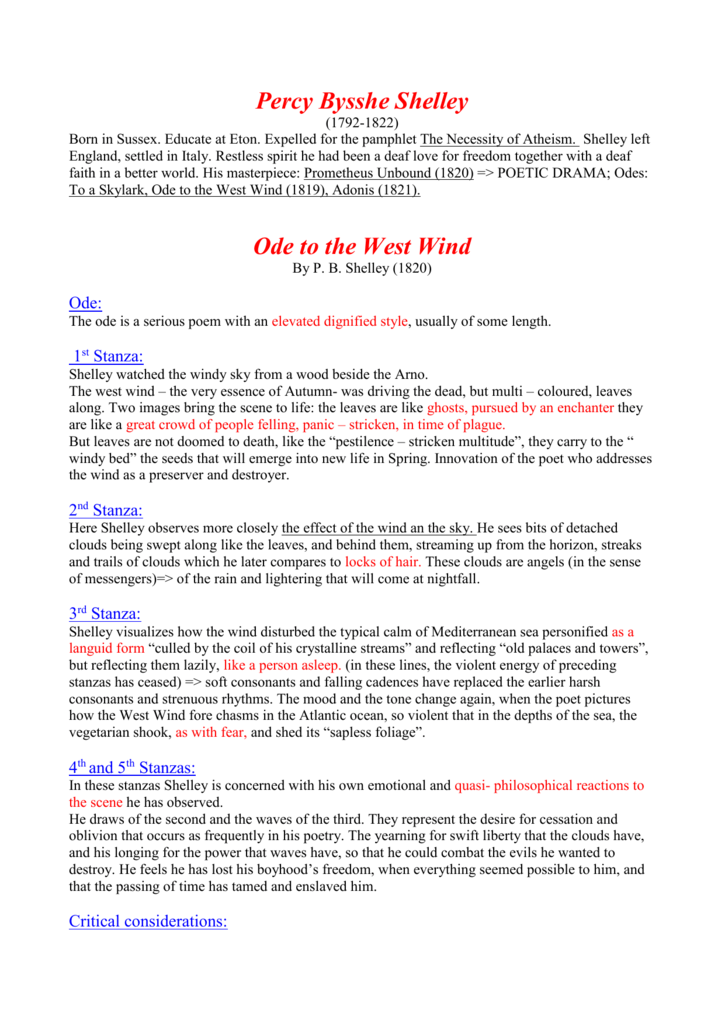
😱 Ode to the west wind summary and analysis. Ode to the West Wind by
Get LitCharts A +. "Ode to the West Wind" is a poem written by the English Romantic poet, Percy Bysshe Shelley. According to Shelley, the poem was written in the woods outside Florence, Italy in the autumn of 1819. In the poem, the speaker directly addresses the west wind. The speaker treats the west wind as a force of death and decay, and.
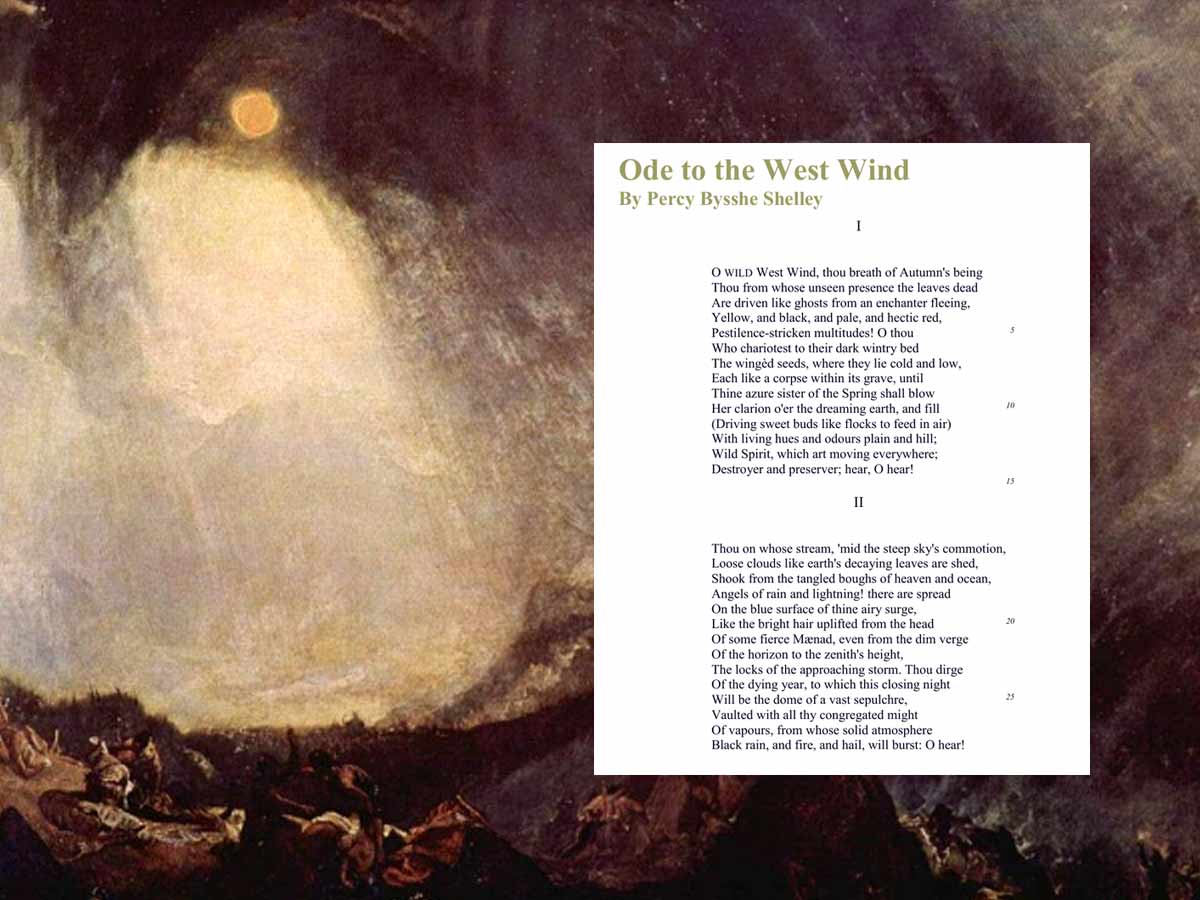
Ode to the West Wind A Deep Analysis of a Beautiful Poem
The west wind is both a stream and a funeral song, and the coming night will be a huge tomb built by rain clouds carried by the wind. In the third stanza, the west wind is the awakener of the Mediterranean Sea, lulled to sleep by its own currents and seeing in its sleep "old palaces and towers . . . overgrown with azure moss and flowers."

Explain the line "If Winter comes, can spring be far behind?" from
Stanza 1, the introductory stanza, explains the West Wind's actions on land. The west wind causes the dead to flee before it, just as a magician causes a ghost to flee as he approaches. The poet refers to the west wind as a wild spirit that moves in all directions and acts as both a destroyer and a preserver. Stanza 2.

Ode to the west wind analysis stanza by stanza LITERATURE7
By: Maple Seawright. Novelty Sense. Percy Shelley's Exaltation of Nature's Power. In "Ode to the West Wind", Percy Bysshe Shelley eloquently expresses his private thoughts about nature and humanity by honoring the virtues and power of the Wind. The consistent rhyme scheme demonstrations his dedication to praising the Wind and admiring nature.

summary of the poem Ode to the West Wind. English compulsory class B.A
Summary. "Ode to the West Wind" is a poem in five cantos, or sections. Each canto is 14 lines long, and the poem is 70 lines total. Canto 1 begins with a direct address to the wind: "O wild West Wind, thou breath of Autumn's being" (Line 1). The speaker continues to describe the West Wind, detailing its unique powers and qualities.

Pin on History ode to the west wind
Stanza-III Explanation of Ode to the West Wind. There is an explanation of certain images of nature in this stanza of Ode to West Wind. The poet uses blue Mediterranean, crystalline streams, isle of Baiae's bay, palaces and towers as beautiful images in this stanza. He imagines the presence of wind on those areas of earth and shows his.

Ode to the West Wind Stanza wise explanation in Urdu/Hindi l Ode to The
Percy Shelley: Poems Summary and Analysis of "Ode to the West Wind". A first-person persona addresses the west wind in five stanzas. It is strong and fearsome. In the first stanza, the wind blows the leaves of autumn. In the second stanza, the wind blows the clouds in the sky. In the third stanza, the wind blows across an island and the waves.
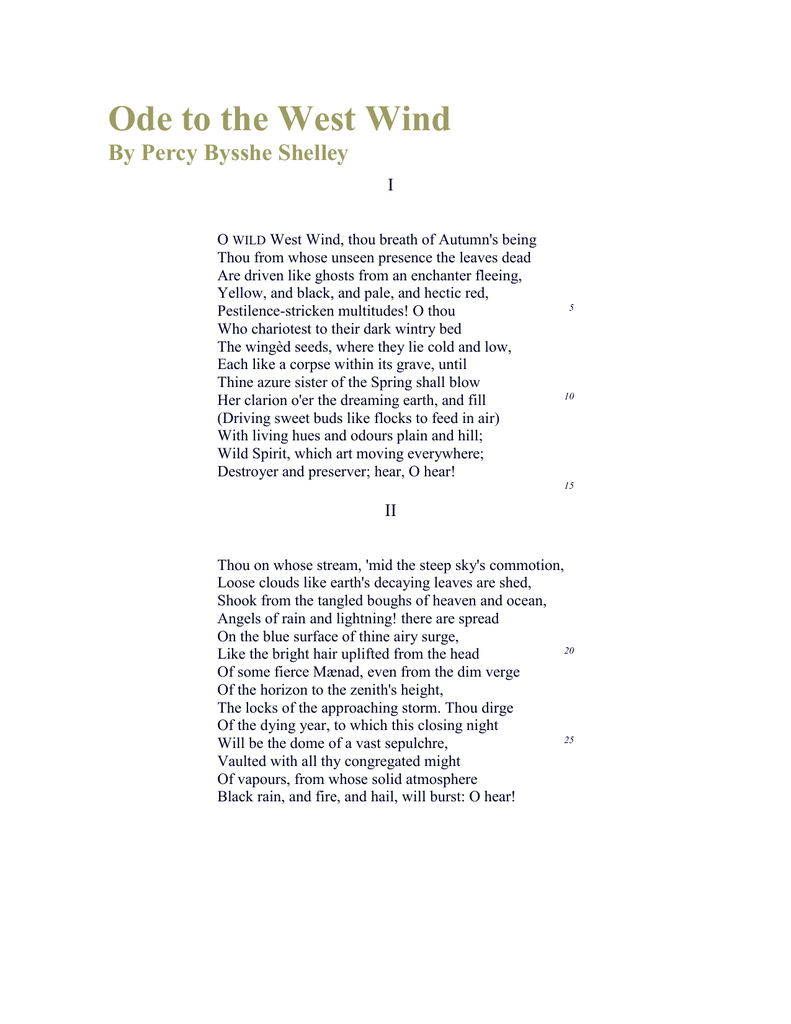
Karu Manifest Zyklop shelley ode to the west wind analysis Plüschpuppe
This ode is composed by Percy Bysshe Shelly in 1819 and it was published in 1820 by Charles as part of the collection, Prometheus Unbound. Shelly is considered as a revolutionary poet which can be clearly seen in his poem "Ode to the West Wind". Shelly, throughout the poem, appeals to the west wind to destroy everything that is old and.
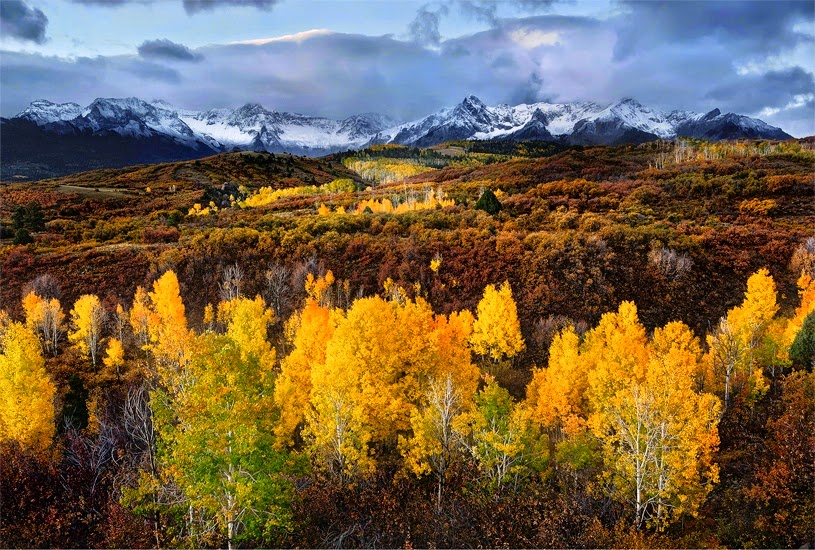
Ode to the West Wind Analysis Stanza by Stanza (2022)
The content of Shelley's "Ode to the West Wind" is powerful in its message, for it reveals and reflects on the power of nature and art. However, the poem's content is reflected in its form.

💐 Shelley west wind. Ode to the West Wind by Percy Bysshe Shelley. 2022
Ode to the West Wind Summary. The speaker of the poem appeals to the West Wind to infuse him with a new spirit and a new power to spread his ideas. In order to invoke the West Wind, he lists a series of things the wind has done that illustrate its power: driving away the autumn leaves, placing seeds in the earth, bringing thunderstorms and the.
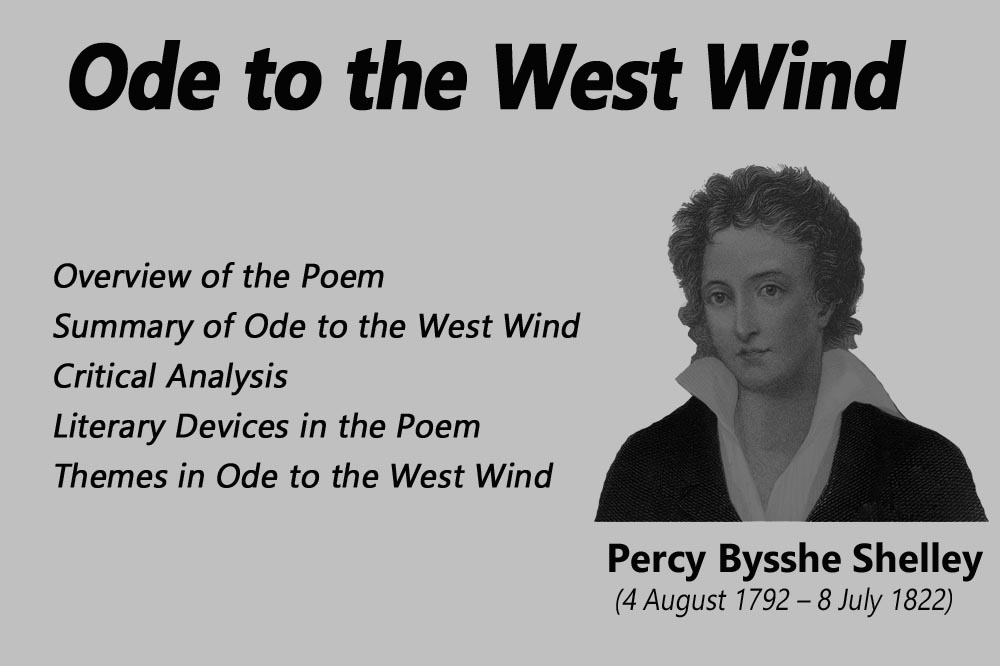
Summary and Analysis of Ode to the West Wind by P. B. Shelley
A summary of "Ode to the West Wind" in Percy Bysshe Shelley's Shelley's Poetry. Learn exactly what happened in this chapter, scene, or section of Shelley's Poetry and what it means. Perfect for acing essays, tests, and quizzes, as well as for writing lesson plans.

from Ode to the West Wind Poems on the Underground
Summary. Last Updated September 6, 2023. Percy Bysshe Shelley's "Ode to the West Wind" reflects the power of the natural world, the cycles of life, and the ability of art to reflect and express.

Ode to the West Wind Analysis Stanza by Stanza Novelty Sense
The best way to go about offering an analysis of 'Ode to the West Wind' is to go through the poem and provide a part-by-part summary, pointing out some of the most important features of Shelley's poem.. 'Ode to the West Wind' was written in 1819 during a turbulent time in English history: the Peterloo Massacre on 16 August 1819,.

Ode to the West Wind Explanation Stanza by Stanza YouTube
Ode to the West Wind Lyrics. [Published with "Prometheus Unbound", 1820.] I. O wild West Wind, thou breath of Autumn's being, Thou, from whose unseen presence the leaves dead. Are driven, like.
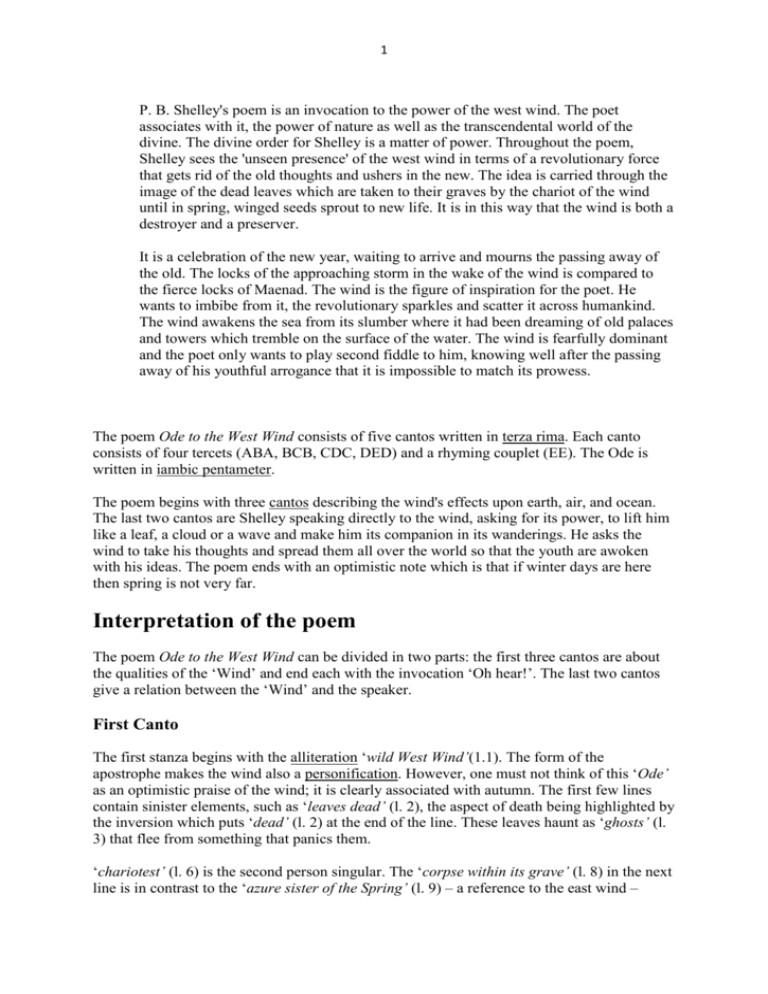
Ode to the West Wind Summary
Ode to the West Wind, poem by Percy Bysshe Shelley, written at a single sitting on Oct. 25, 1819.It was published in 1820. Considered a prime example of the poet's passionate language and symbolic imagery, the ode invokes the spirit of the West Wind, "Destroyer and Preserver," the spark of creative vitality. This ode introduced a new stanzaic form composed of five sonnets, each of which.

Ode to the West Wind Stanza I Percy Bysshe ShelleyUnderstanding
Analysis of Ode to the West Wind Canto 1 Stanza One. O wild West Wind, thou breath of Autumn's being, Thou, from whose unseen presence the leaves dead Are driven, like ghosts from an enchanter fleeing, In the opening stanza of Ode to the West Wind, the speaker appeals to the wild West Wind. The use of capital letters for "West" and.
